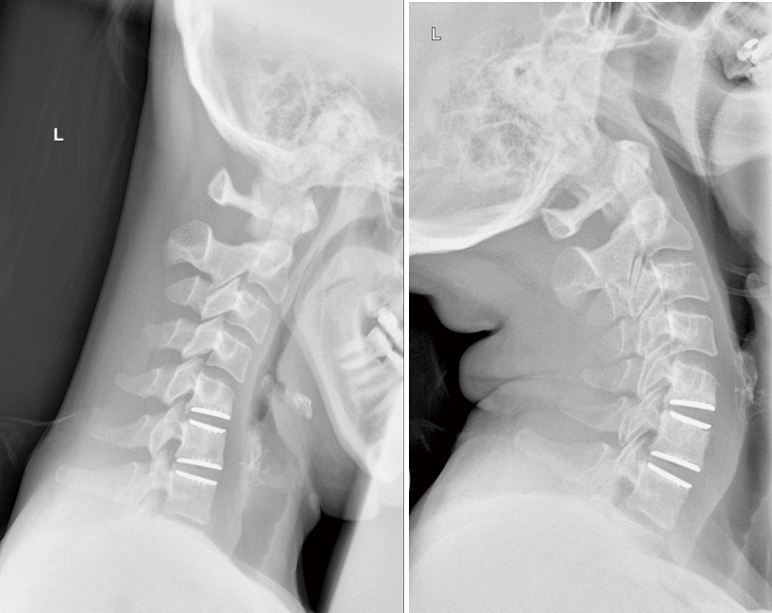By Dr. Kingsley Chin
Scientific Paper
Kingsley Richard Chin, Jacob Ryan Lubinski, Kari Bracher Zimmers, Barry Eugene Sands, Fabio Pencle
Interested medical professionals can read through the full paper, as published in the Journal of Spine Surgery, here.
The AxioMed Freedom Cervical Disc
Background
The purpose of this study is to present clinical outcome data from a 2-year post-market study of a viscoelastic one-piece cervical total disc replacement (TDR) in Europe.
Methods
Thirty-nine patients were implanted at five surgical sites in an European post-market clinical study. Clinical outcomes included improvement of neck disability index (NDI) and visual analog scale scores for neck and arm pain from baseline to 2-year follow-up, neurological examinations, patients view on the success of surgery, complications, and subsequent surgical interventions..
Results
Thirty patients had the Freedom® Cervical Disc (FCD) implanted at a single level, and nine patients were implanted at two adjacent levels. The population had a similar distribution of male [20] and female [19] subjects, with a mean age of 45 years. All self-administered outcome measures showed significant clinically important improvements from baseline to the 2-year follow-up. Mean preoperative NDI score improved from 48% to 20%, 13%, 8%, 6% and 4% at 6 weeks, 3, 6, 12, and 24 months, respectively. Average preoperative visual analog scale (VAS) scores of the neck, right and left arm pain intensity and frequency showed significant improvement. All neurological outcome measurements showed immediate improvement from preoperative values and continued improvement throughout 2 years follow-up. From pre-op to 24 months, neurological deficits declined in the population from 21% to 6% for reflex function, 62% to 17% for sensory function, and 38% to 3% for motor function. No patients experienced a deterioration in any measured outcomes compared with the preoperative situation. Patient satisfaction increased over 2 years post-op, with 83% of patients responding that they would “definitely” choose to have the same treatment for their neck/arm condition and another 11% responding that they would “probably” choose to have the same treatment.
Lateral flexion and extension X-rays of TDR at C6/C7 at 2 years. TDR, total disc replacement.
Lateral flexion and extension X-rays of TDRs at C5/C6 and C6/C7 at 1 year. TDR, total disc replacement.
Conclusions
The FCD performs as expected in patients with single-level and two-level degenerative disc disease.
About Author Dr. Kingsley R. Chin
Dr. Kingsley R. Chin, Founder of philosophy and practice of The LES Society and The LESS Institute
Dr. Kingsley R. Chin, Founder of philosophy and practice of The LES Society and The LESS Institute
Dr. Kingsley R. Chin is a board-certified Harvard-trained Orthopedic Spine Surgeon and Professor with copious business and information technology exposure. He sees a niche opportunity where medicine, business and info. tech meet – and is uniquely educated at the intersection of these three professions. He has experience as Professor of Clinical Biomedical Sciences & Admissions Committee Member at the Charles E. Schmidt College of Medicine at Florida Atlantic University, Professor of Clinical Orthopedic Surgery at the Herbert Wertheim College of Medicine at Florida International University, Assistant Professor of Orthopaedics at the University of Pennsylvania Medical School, Visiting Spine Surgeon & Professor at the University of the West Indies, Mona, and Adjunct Professor of Clinical Biomedical Sciences at the University of Technology, Jamaica.
Learn more about Dr. Chin here and connect via LinkedIn.
About Less Exposure Surgery
Less Exposure Surgery (LES) is based on a new philosophy of performing surgery, leading the charge to prove through bench and clinical outcomes research that LES treatment options are the best solutions – to lowering the cost of healthcare, improving outcomes and increasing patient satisfaction. Learn more at LESSociety.org.
The LES Society philosophy: “Tailor treatment to the individual aiding in the quickest recovery and return to a pain-free lifestyle, using LES® techniques that lessen exposure, preserve unoffending anatomy and utilize new technologies which are safe, easy to adopt and reproducible. These LES®techniques lessen blood loss, surgical time and exposure to radiation and can be safely performed in an outpatient center. Less is more.” – Kingsley R. Chin, MD
About The LESS Institute
The LESS Institute is the world leader center of excellence in Less Exposure Surgery. Our safe, effective outpatient treatments help patients recover quickly, avoid expensive hospital stays and return home to their family the same day. Watch our patient stories, follow us on Facebook and visit TheLESSInstitute.com to learn more.
Scientific Paper Author & Citation Details
Authors
Kingsley Richard Chin¹, Jacob Ryan Lubinski¹, Kari Bracher Zimmers¹, Barry Eugene Sands², Fabio Pencle³
Author information
¹AxioMed LLC, Malden, MA, USA; ²RQMIS, Inc. Amesbury, MA, USA; ³Less Exposure Surgery Society, Malden, MA, USA Contributions: (I) Conception and design: All authors; (II) Administrative support: KB Zimmers, BE Sands; (III) Provision of study materials or patients: BE Sands; (IV) Collection and assembly of data: BE Sands; (V) Data analysis and interpretation: BE Sands, KB Zimmers; (VI) Manuscript writing: All authors; (VII) Final approval of manuscript: All authors. Correspondence to: Kari Bracher Zimmers. AxioMed LLC, Malden, MA, USA. Email: kzimmers@axiomed.com






